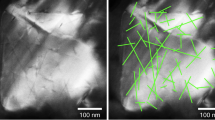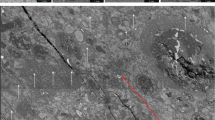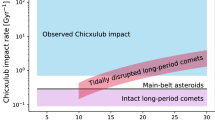Abstract
Throughout the history of the Solar System, Earth has been bombarded by interplanetary dust particles (IDPs), which are asteroid and comet fragments of diameter ∼1–1,000 µm. The IDP flux is believed to be in quasi-steady state: particles created by episodic main belt collisions or cometary fragmentation replace those removed by comminution, dynamical ejection, and planetary or solar impact. Because IDPs are rich in 3He, seafloor sediment 3He concentrations provide a unique means of probing the major events that have affected the IDP flux and its source bodies over geological timescales1,2,3,4. Here we report that collisional disruption of the >150-km-diameter asteroid that created the Veritas family 8.3 ± 0.5 Myr ago5 also produced a transient increase in the flux of interplanetary dust-derived 3He. The increase began at 8.2 ± 0.1 Myr ago, reached a maximum of ∼4 times pre-event levels, and dissipated over ∼1.5 Myr. The terrestrial IDP accretion rate was overwhelmingly dominated by Veritas family fragments during the late Miocene. No other event of this magnitude over the past ∼108 yr has been deduced from main belt asteroid orbits. One remarkably similar event is present in the 3He record 35 Myr ago, but its origin by comet shower1 or asteroid collision6 remains uncertain.
This is a preview of subscription content, access via your institution
Access options
Subscribe to this journal
Receive 51 print issues and online access
$199.00 per year
only $3.90 per issue
Buy this article
- Purchase on Springer Link
- Instant access to full article PDF
Prices may be subject to local taxes which are calculated during checkout


Similar content being viewed by others
References
Farley, K. A., Montanari, A., Shoemaker, E. M. & Shoemaker, C. S. Geochemical evidence for a comet shower in the Late Eocene. Science 280, 1250–1253 (1998)
Takayanagi, M. & Ozima, M. Temporal variation of 3He/4He in deep-sea sediment cores. J. Geophys. Res. 92, 12531–12538 (1987)
Farley, K. A. Cenozoic variations in the flux of interplanetary dust recorded by 3He in a deep-sea sediment. Nature 376, 153–156 (1995)
Kortenkamp, S. & Dermott, S. A 100,000-year periodicity in the accretion rate of interplanetary dust. Science 280, 874–876 (1998)
Nesvorný, D., Bottke, W. F., Levison, H. F. & Dones, L. Recent origin of the solar system dust bands. Astrophys. J. 591, 486–497 (2003)
Tagle, R. & Claeys, P. Comet or asteroid shower in the late Eocene? Science 305, 492 (2004)
Burns, J. A., Lamy, P. L. & Soter, S. Radiation forces on small particles in the Solar-System. Icarus 40, 1–48 (1979)
Farley, K. A., Love, S. G. & Patterson, D. B. Atmospheric entry heating and helium retentivity of interplanetary dust particles. Geochim. Cosmochim. Acta 61, 2309–2316 (1997)
Patterson, D. B. & Farley, K. A. Extraterrestrial He-3 in seafloor sediments: Evidence for correlated 100 kyr periodicity in the accretion rate of interplanetary dust, orbital parameters, and Quaternary climate. Geochim. Cosmochim. Acta 62, 3669–3682 (1998)
Mukhopadhyay, S., Farley, K. & Montanari, A. A 35 Myr record of helium in pelagic limestones: implications for interplanetary dust accretion from the early Maastrichtian to the Middle Eocene. Geochim. Cosmochim. Acta 65, 653–669 (2001)
Shackleton, N. J., Curry, W. B., Richter, C. & Bralower, T. J. Ceara Rise. Proc. ODP Sci. Res. 154, 1–552 (1997)
Bottke, W. F. et al. The fossilized size distribution of the main asteroid belt. Icarus 175, 111–140 (2005)
Low, F. J. et al. Infrared cirrus—new components of the extended infrared-emission. Astrophys. J. 278, L19–L22 (1984)
Dermott, S. F., et al. in Interplanetary Dust (eds Grün, E., Gustafson, B. A. S., Dermott, S. F. & Fechtig, H.) 569–639 (Springer, Berlin, 2001)
Nesvorný, D., Vokrouhlický, D., Bottke, W. F. & Sykes, M. Physical properties of asteroid dust bands and their sources. Icarus (submitted)
Morbidelli, A. & Nesvorný, D. Numerous weak resonances drive asteroids toward terrestrial planet orbits. Icarus 139, 295–308 (1999)
Gladman, B. J. et al. Dynamical lifetimes of objects injected into asteroid belt resonances. Science 277, 197–201 (1997)
Bottke, W. F. et al. Debiased orbital and absolute magnitude distribution of the near-earth objects. Icarus 156, 399–433 (2002)
Grün, E., Zook, H. A., Fechtig, H. & Giese, R. H. Collisional balance of the meteoritic complex. Icarus 62, 244–272 (1985)
Nolan, M. C. & Greenberg, R. Stochastic-evolution of asteroids to produce the ordinary chondrites. Meteoritics 24, 310 (1989)
Bottke, W. F. et al. in Dynamics of Populations of Planetary Systems (eds Knezevic, Z. & Milani, A.) 357–376 (IAU Colloquium 197, Cambridge Univ. Press, Cambridge, UK, 2005)
Graf, T. & Marti, K. Collisional history of H chondrites. J. Geophys. Res. 100, 21247–21263 (1995)
Burbine, T. H., McCoy, T. J., Meibom, A., Gladman, B. & Keil, K. in Asteroids III (eds Bottke, W. F., Cellino, A., Paolicchi, P. & Binzel, R. P.) 653–667 (Univ. Arizona Press, Tucson, 2002)
Bogard, D. D. Impact ages of meteorites—A synthesis. Meteoritics 30, 244–268 (1995)
Muller, R. A. & MacDonald, G. J. Glacial cycles and astronomical forcing. Science 277, 215–218 (1997)
Marcantonio, F. et al. Extraterrestrial 3He as a tracer of marine sediment transport and accumulation. Nature 383, 705–707 (1996)
Gupta, A. K., Singh, R. K., Joseph, S. & Thomas, E. Indian Ocean high-productivity event (10–8 Ma): Linked to global cooling or to the initiation of the Indian monsoons? Geology 32, 753–756 (2004)
Curry, W. B., et al. ODP Init. Rep. Leg 154 1–1111, (1995)
Acknowledgements
Financial support for this project was provided by NASA's Planetary Geology & Geophysics program (W.F.B., D.N. and K.A.F.). Financial and travel support for D.V. was provided by the Czech Republic grant agency and NSF's COBASE program. We also thank D. Durda, A. Morbidelli, M. Sykes and S. Mukhopadhyay for several discussions, and S. Goldstein and J. Burns for comments and suggestions.Author Contributions K.A.F. measured 3He in the seafloor sediments. D.N. determined the age of the Veritas family using numerical integration methods. D.V., W.F.B. and D.N. constructed the Monte Carlo dust evolution code and analysed the results.
Author information
Authors and Affiliations
Corresponding author
Ethics declarations
Competing interests
Reprints and permissions information is available at npg.nature.com/reprintsandpermissions. The authors declare no competing financial interests.
Supplementary information
Supplementary Notes
This file contains detailed information on samples, methods, and age models, and tabulates and plots the complete He data set. It also presents details on the IDP production model following Veritas collision and a plot showing the time constraints on the Veritas collision based on orbital backtracking. Brief discussions of other asteroid break-up events and on possible relationships between the Late Miocene and Late Eocene 3He events are also given. (PDF 1147 kb)
Rights and permissions
About this article
Cite this article
Farley, K., Vokrouhlický, D., Bottke, W. et al. A late Miocene dust shower from the break-up of an asteroid in the main belt. Nature 439, 295–297 (2006). https://doi.org/10.1038/nature04391
Received:
Accepted:
Issue Date:
DOI: https://doi.org/10.1038/nature04391
This article is cited by
-
Ancient and recent collisions revealed by phosphate minerals in the Chelyabinsk meteorite
Communications Earth & Environment (2022)
-
Asteroid families: properties, recent advances, and future opportunities
Celestial Mechanics and Dynamical Astronomy (2022)
-
Enhanced flux of extraterrestrial 3He across the Permian–Triassic boundary
Progress in Earth and Planetary Science (2019)
-
Impacts of Cosmic Dust on Planetary Atmospheres and Surfaces
Space Science Reviews (2018)
-
Recent near-Earth supernovae probed by global deposition of interstellar radioactive 60Fe
Nature (2016)
Comments
By submitting a comment you agree to abide by our Terms and Community Guidelines. If you find something abusive or that does not comply with our terms or guidelines please flag it as inappropriate.



